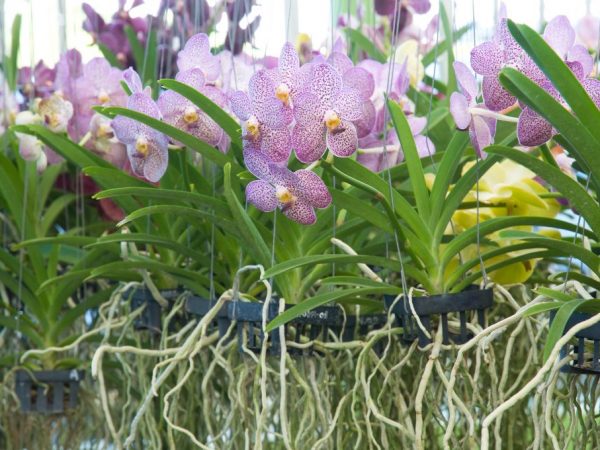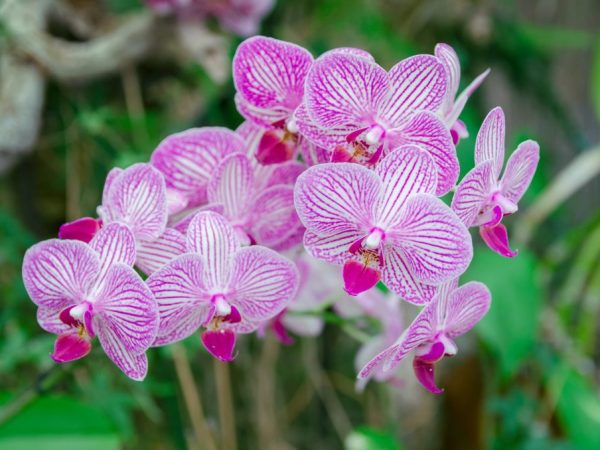What are the features of a crown pot for orchids
Home, indoor orchid is one of the most delicate and elegant flowers. But his beauty requires a reverent attitude, good care, care and attention every day. An important factor is how and where it grows. A special crown pot for an orchid will solve many issues related to care and watering.

Features of the Crown pot for orchids
General care rules
Indoor orchids have several varieties and types. Each of them differs in its color and flower shape.
Proper care will ensure that the plant is in good condition and blooms for a long time. The basic rules of care include:
- location selection;
- watering;
- lighting;
- air humidity;
- choice of a pot with a tray or pots.
Each of these points is important. But one should start with the choice of a vessel in which this indoor splendor will spend its life.
Description of the pot
In natural conditions, the orchid is attached with roots to stones or branches. Therefore, it is better to plant it at home in a pot with holes to drain excess moisture and good ventilation.
The Corona pot will be a good choice because it was designed specifically for orchids, taking into account all the characteristics of the plants.
The device can be described as follows:
- disc bottom base;
- in a circle (along its radius) there are pegs, like a palisade;
- ventilation gaps between the pegs;
- hitch with pallet in the form of grooves
The peculiarity of this design and the difference from other ordinary flower pots is the excellent ventilation of the root system. It is ventilation that prevents root rot from developing in epitaph representatives of the genus.
The container is installed above the level of the bottom of the pallet, into which water is poured and gradually evaporating, it provides the necessary moisture. This design creates a good humid microclimate around the entire flower. The crown is suitable for such lithophytic species:
- phalaenopsis;
- wanda;
- dendrobium;
- cattleya;
- etc.
Advantages and disadvantages of the Crown
Like any design, a pot designed specifically for exotic flowers has its own advantages and disadvantages.
Main advantages
The main advantages include:
- good ventilation;
- good lighting of the roots;
- optimal size;
- wide range of colors of designs;
- ease.
The range of colors is so wide that it is easy to find the right color for any interior. The flowerpot is lightweight and easy to use. The view is unusual, but interesting. Mold on the roots in such a pot will never appear.

The flower needs good care
The transparency of the walls allows you to see the state of the substrate and roots. If necessary, quickly eliminate the lack of care
Corona is safe because made of material that does not emit toxins.
Large holes make it possible to use a large substrate and avoid root germination.
disadvantages
The blowing of the pot from all sides reduces humidity in the hot atmosphere of the apartment. Therefore, it is necessary to water the plant more often.
In greenhouses or large greenhouses, humidity is maintained artificially, so this disadvantage is invisible.
Light weight entails accidental falls, resulting in stem breakage. They are fragile in orchids and will not withstand impact on a hard floor or wall.
When using a shallow substrate, the roots grow outward and difficulties arise during transplantation. Sometimes the root system is damaged. To prevent this from happening, it is better to use sphagnum for the lower layer.
How to choose a design
The crown can be either a pot or a planter.
The size of the pot should be chosen in full accordance with the size of the flower. Cramped and too loose will not do. Orchids do not like a lot of substrate and do not tolerate tightness for the roots.
The height of the pot should be the same as the orchid, and the width of the container should be chosen according to the width of the roots.
If a planter is needed, then the size should be such that the pot freely becomes inside it.
When transplanting, the size chooses 10% larger than the previous one.
The consequences of a wrong choice
A small volume will lead to the fact that the root system will not receive the required amount of air and moisture for proper development. Leaf cover and flowering will suffer from this.
Excessive volume will lead to waterlogging of the substrate and rotting of the root system. What can cause the death of the plant.
When choosing a container, you need to measure the distance from the edge to the flower. It should be equal to 1-1.5 cm. Slots, slots in the Crown should be selected taking into account the humidity of the room in which the orchid will be located. For a dry room, the slots can only be at the bottom. Then drainage is done on a pallet. If the room is humid, then the cracks can be both at the bottom and on the sides.
Transfer to Corona
The transplant is done in a washed pot. A substrate is poured onto its bottom, which will take 1/3 of the volume. Then the plant is placed in the center. The root system, all processes are gently spread in different directions. If they do not fit and look outward, they should not be forcibly pushed into the structure. They can break. Leave them outside.
Pour the substrate into the remaining space. Tamping is not needed in this case. But the flower should stand firmly and firmly in one position, not staggering or bending over.
As a temporary support, you can adapt light wire and twine, securing them along the edges.
Do not water for 3-5 days. At this time, it is better to spray. Full rooting will occur in 2 weeks. To speed up the process, the flower can be covered with a light, airy cloth and placed so that the sun does not shine directly on the transplanted plant.
In the future, water in the usual way or by immersion.
Conclusion
The crown is the best solution to all problems when growing orchids. Exotic flower care is a real pleasure. Flowering will be long and lush.

